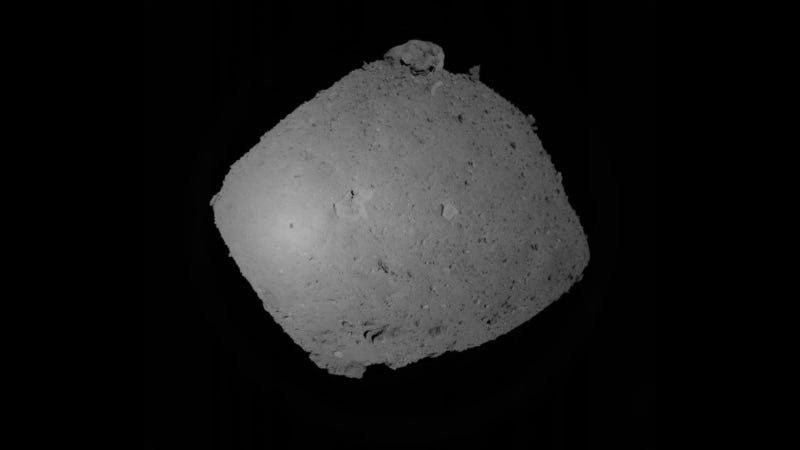 A view of the Ryugu asteroid during the September 12 rehearsal. This image was taken when Hayabusa2 was at a distance of 2,080 feet (635 meters). Amazingly, you can actually see the shadow of Hayabusa2—it’s that tiny dark spot in the bright region at center left (the brightness is caused by the Sun’s reflection).Image: JAXA
A view of the Ryugu asteroid during the September 12 rehearsal. This image was taken when Hayabusa2 was at a distance of 2,080 feet (635 meters). Amazingly, you can actually see the shadow of Hayabusa2—it’s that tiny dark spot in the bright region at center left (the brightness is caused by the Sun’s reflection).Image: JAXA
Japan’s Hayabusa2 project experienced a (hopefully) minor setback yesterday when the spacecraft failed to complete a practice session during preparations for its much-anticipated touchdown on the Ryugu asteroid.
Launched by JAXA in December 2014, the Hayabusa2 spacecraft will attempt to extract material from the surface of Ryugu, a 3,000-foot-wide (900 meters) asteroid located approximately 180 million miles (290 million kilometers) from Earth. The probe will return to Earth with a precious asteroid sample in late 2020, should all go according to plan.
Hayabusa2 arrived at Ryugu in June, and everything has gone absolutely swimmingly since then, with the probe snapping some super cool pictures of this weirdly shaped asteroid. Yesterday, however, mission planners experienced the first glitch in the mission, when the probe balked during its first touchdown rehearsal.
In preparation for the touchdown, which is set for late October, mission planners have scheduled a number of rehearsals, the first of which transpired between September 10 and 12. The goal of the first rehearsal, dubbed TD1-R1, was to have Hayabusa2 come to within 130 feet (40 meters) of the asteroid’s surface. Following that, the probe would return to its home position, about 12 miles (20 kilometers) from the center of Ryugu. The purpose of TD1-R1 was to “confirm the operation of the probe to perform touchdown and to confirm the safety of the touchdown candidate point by photographing the surface… from a close distance,” according to a JAXA statement.
Unfortunately, things didn’t go as planned. On the third day of TD1-R1 (September 12), the autonomous probe suddenly stopped its descent when it reached a distance of 2,000 feet (600 meters), and it began to rise back up.
JAXA isn’t sure why this happened, but it says the problem may have something to do with the spacecraft’s laser altimeter, the LIDAR instrument, which measures the distance between the probe and the surface of the asteroid. JAXA says the asteroid’s low reflectivity may have prevented the laser altimeter from working properly; Hayabusa2 automatically stopped its descent the moment it could no longer measure its distance to the asteroid.
Aside from this incident, everything else appears to be fine, and Hayabusa2 is still performing normally. The probe is currently returning to its home position in orbit around Ryugu. JAXA is now preparing for the second rehearsal, which—fingers crossed—will hopefully go much better. In preparation, the JAXA team is working on a new descent procedure, which includes a review of LIDAR and its settings.
Ryugu’s surface as seen from a distance of about 0.6 miles (1 km)Image: JAXA, Tokyo University, Kochi University, Rikkyo University, Nagoya University, Chiba Institute of Technology, Meiji Univ., Aizu Univ., AIST
There’s no need to panic yet, but if the second rehearsal doesn’t go well, that would obviously not be a good sign. This is a hugely ambitious mission with lots of moving parts, so setbacks should be expected. What’s more, a quick glance at Ryugu’s surface shows it’s an unwelcoming place, one littered with all sorts of nooks and crannies and no shortage of sharp rocks. Should the mission go well, and Hayabusa2 returns to Earth with its samples in 2020, that would represent a tremendous accomplishment, indeed.
Correction: A previous version of this article gave the incorrect distance of Ryugu to Earth.
[JAXA]